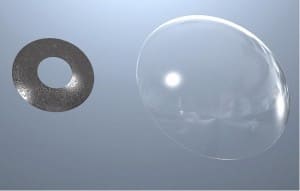Understanding the loss of near vision
A healthy, young eye is able to focus light from both far and near objects to create a clear image at all distances. By age 45, the eye’s natural lens is too stiff to focus on near points. As a result, near tasks like reading or computer work are blurry. This is a natural occurrence that affects us the rest of our life. The clinical term for the loss of near vision is presbyopia (prez-bee-‘O-pee-uh). It is possible to have poor near vision, but good distance vision.
Buying a pair of reading glasses is a quick way to improve near vision. While “readers” will help you read a book or dial a telephone number, they will not help you see far objects. Some find putting glasses on to see near and taking off to see far inconvenient.
The ACI Corneal Inlay is an investigational device. A no-cost clinical research study is currently underway. The purpose of the study is to examine the safety and effectiveness of the inlay.
The ACI Corneal Inlay no-cost research study
 Smaller than a contact lens, the ACI Corneal Inlay looks like a black ring. There is a tiny aperture or hole in the center of the inlay. The inlay may help to improve vision in two ways.
Smaller than a contact lens, the ACI Corneal Inlay looks like a black ring. There is a tiny aperture or hole in the center of the inlay. The inlay may help to improve vision in two ways.
- Creates a pinhole effect so near objects are clearer.
- Focuses light rays so you can see a wider range of vision – near, intermediate (computer) and distance. During an out-patient procedure, the research doctor will implant the inlay in one eye. If needed, the ACI Corneal Inlay can be surgically removed.
You may be eligible to participate in the study if you are…
- Between the ages of 45 and 60.
- Using reading glasses to read or work on the computer.
- Not using glasses or contacts to see far objects.
- In good physical health.
- Able to meet other medical criteria determined by the research doctor.
Improvement in near vision
The amount of time it takes to see an improvement in near vision varies. Some see better in a few days. For others, it takes several months, or there may be no improvement at all.
You can help your eye heal faster by using eye drops as prescribed. You will also be asked to practice reading without glasses. This activity will help train your inlay eye how to see near again.
The goal of the inlay is to reduce your need for reading glasses. You may continue to need glasses for reading very small print or in dim light.
Next steps
If you are interested in learning if the ACI Corneal Inlay can reduce your dependence on reading glasses, contact Gordon Schanzlin New Vision Institute by telephone (858-455-6800) or email (gbwvi@gordonweissvision.com). You can also visit www.NearVisionStudy.com for more information.
The information about the ACI Corneal Inlay clinical research study is not intended to provide medical advice. Always consult your doctor for medical advice and treatment.
Caution: Investigational device. Limited by United States federal law to investigational use.

